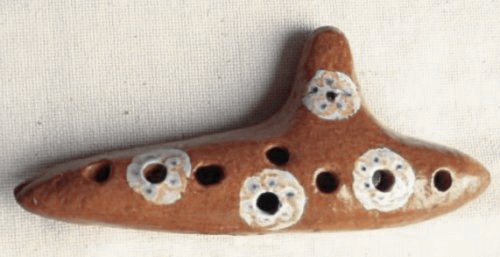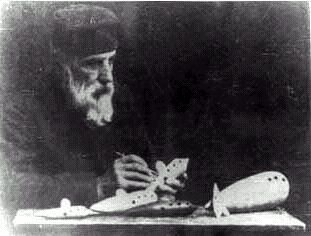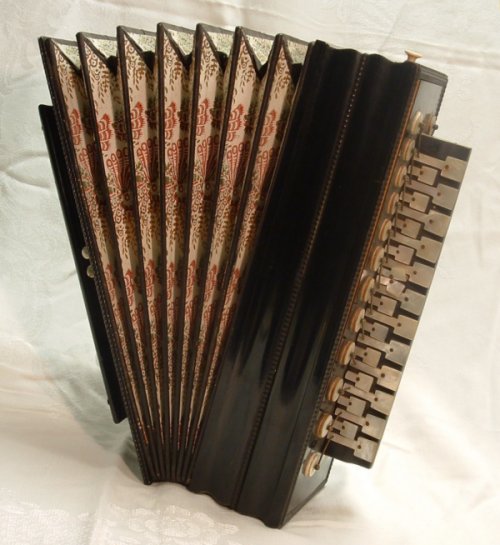Guido s father, Count Carlo, was a tyrant and ran his family with an iron hand. He demanded complete obedience and worked his two sons like serfs. Perhaps Carlo considered this an economic necessity, as the continual state of war in Northern Italy had depleted the manpower pool which left only the very young, old, or connected, to do the work necessary to keep food on the table.
As a young lad Guido many times fell asleep walking alongside the goods wagon on the long road to market. He held onto the wagon with one or two hands and learned to sleep while walking.

A clay ocarina
|
While a young boy, Guido entertained himself by playing the ocarina (sometimes known as "sweet potato ocarina"), an ancient flute-like wind instrument usually made from ceramic or wood. Its common use in the Western countries dates to the 19th century, when the modern form of the ocarina was invented by the Italian brickmaker Giuseppe Donati (1836-1925), who established ocarina-making workshops in Budrio and later in Bologna. The name is derived from Italian: ocarina = little goose.

Giuseppe Donati with his ocarinas.
|
Guido s uncle Frederico noticed Guido s unusual musical ability on the ocarina, and decided to get the boy a more sophisticated instrument, to see where his musical endeavors might lead. During a trip to Germany, Uncle Frederico acquired a diatonic button-accordion with nine keys on the treble right-hand manual and two bass/chord buttons on the left-hand manual, and presented the instrument his nine-year-old nephew.
Guido taught himself to play this instrument by ear, and progressed rapidly. One day Frederico asked Guido to play for him, and Guido refused. Frederico became insulted, picked up the little accordion, and smashed it on Guido s head, as if to say, If you won t play for me, you won t play for anybody.
Curiously, Guido saw this as a blessing. Years later he explained, I think that incident, later on, had a lot to do in making me become a real player. Perhaps Guido hinted in this statement that his uncle Frederico had taught him that Guido's musical talent was given by God not only for Guido's own pleasure, but for the pleasure of others.

A two-row diatonic accordion similar to Guido's second accordion purchased for him by his father. Click on image to enlarge.
From the collection of A World of Accordions Museum in Superior, Wisconsin. Photograph by Henry Doktorski.
|
Although as a rule Carlo did not approve of his son s infatuation with music, after his brother Frederico broke Guido's first accordion he nevertheless purchased a second accordion for Guido: a larger and more expensive instrument with two rows of keys for the right hand and eight bass/chord buttons.
Guido quickly mastered this instrument, and played by ear many popular Italian folk tunes, such as waltzes, polkas, mazurkas, and marches. He also learned to play popular melodies from the great Italian operas by Bellini, Verdi, Puccini, Donizetti and others. During this time, opera was as popular in Italy as baseball was in the United States. Practically everyone, from the wealthy nobles to the poor peasants, regularly attended local opera productions, and they sang and whistled the famous melodies while at home or at work.
Carlo allowed Guido to play this two-row accordion in the street outside his stores because Guido s fine playing would draw a crowd and attract potential customers. Guido was required to attend grade school, but only after all his chores were finished. After completing the eighth grade, Carlo forbid Guido from attending high school. Now you are a man and you must work fulltime for the family business. Yet Carlo could also be generous; he purchased a second instrument for his son after the first instrument was smashed by Frederico, and he also permitted Guido to keep half the money he made in tips from playing for weddings and parties. The other half must be given to his father.
Guido left home probably at the age of seventeen and moved to Metz, Germany. During this time he became a student of the famous Italian accordionist-composer, Giovanni Gagliadi.

